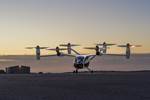Spirit AeroSystems to build new composite fuselage for HondaJet
A build-to-print composite fuselage and composite bonded frame are part of the work agreement with Honda Aircraft Company for its HondaJet 2600 concept.
Spirit AeroSystems (Wichita, Kan., U.S.) has announced an expansion of its manufacturing role for Honda Aircraft Co.’s (Greensboro, N.C., U.S.) new light jet that was first introduced at the 2021 NBAA-BACE as the HondaJet 2600 concept. The work includes an innovative build-to-print composite fuselage and a composite bonded frame. The new statement of work builds on Spirit’s technical expertise to implement affordable design and manufacturing efficiencies.
“This agreement expands our Regional and Business Jet portfolio and is a testament to our expertise in advanced materials and processes,” Alex Bellamy, vice president of regional and business jet programs at Spirit AeroSystems, says. “Our experienced and diverse teams worldwide continue demonstrating our capabilities in building next-generation aircraft.”
Spirit leverages decades of design and manufacturing expertise and its Tier 1 status as a provider of end-to-end aerostructure solutions for regional and business jets. It covers the full lifecycle from design through to aftermarket support. The company emphasizes its expertise in composite and metallic aerostructures for a wide range of business jet models, from wing structures to fuselage components and complex assemblies. Spirit also offers a range of cutting-edge solutions that are designed to improve performance, reduce costs and increase safety.
According to the company, the new light jet designed by Honda Aircraft Co. will surpass the performance, comfort and efficiency of typical light jets by providing a medium-sized jet experience. It is designed to be the first light jet capable of nonstop transcontinental flight across the U.S. with a quiet and spacious cabin suited for long-range travel and the ability to accommodate up to 11 occupants. The new light jet is expected to deliver up to 20% better fuel efficiency compared to typical light jets, and more than 40% better fuel efficiency than medium-sized jets during a typical mission.
Related Content
-
Materials & Processes: Resin matrices for composites
The matrix binds the fiber reinforcement, gives the composite component its shape and determines its surface quality. A composite matrix may be a polymer, ceramic, metal or carbon. Here’s a guide to selection.
-
One-piece, one-shot, 17-meter wing spar for high-rate aircraft manufacture
GKN Aerospace has spent the last five years developing materials strategies and resin transfer molding (RTM) for an aircraft trailing edge wing spar for the Airbus Wing of Tomorrow program.
-
Plant tour: Spirit AeroSystems, Belfast, Northern Ireland, U.K.
Purpose-built facility employs resin transfer infusion (RTI) and assembly technology to manufacture today’s composite A220 wings, and prepares for future new programs and production ramp-ups.














